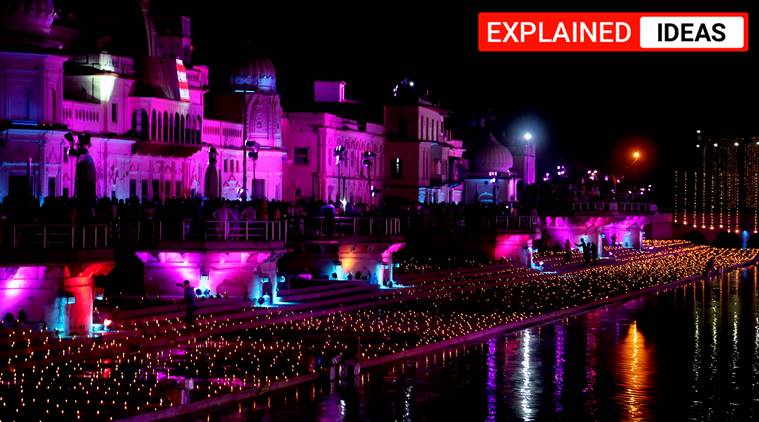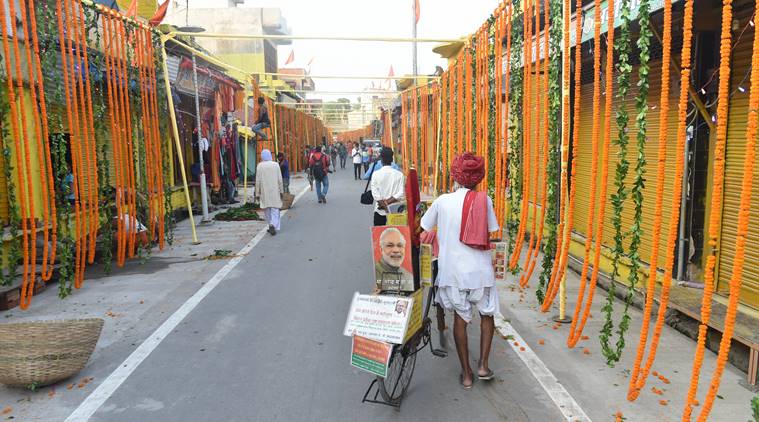Explained Ideas: How to view the Bhoomi pujan ceremony of Ram temple in Ayodhya
Ayodhya Ram Mandir Bhoomi Pujan: The Ram Temple represents a shared sentiment of sacredness according to Ram Madhav, but for Pratap Bhanu Mehta, it is the first real colonisation of Hinduism by political power.
 In Ayodhya, on the eve of the ground breaking ceremony of the Ram Temple, on August 4, 2020. (Express Photo: Prem Nath Pandey)
In Ayodhya, on the eve of the ground breaking ceremony of the Ram Temple, on August 4, 2020. (Express Photo: Prem Nath Pandey)
Ayodhya Ram Mandir Bhoomi Pujan: Ahead of the Ram temple “Bhoomi pujan” in Ayodhya on August 5, The Indian Express’ opinion pages carry the views of several commentators on this topic.
Ram Madhav, national general secretary of the BJP, writes that “Places like Ayodhya represent a universal sentiment of sacredness, not merely because of their association with the epic Ramayana and its hero Ram, but also because of a value system that they represented”.
Madhav points out that “Ram is a god to many. But the sage Valmiki presents him both as an avatar of Vishnu as well as an ideal human being”. The Prime Minister will be laying the foundation of those great values, hidden in the fabulous tale of Ayodhya that has for millennia been — and then Madhav quotes historian William Dalrymple — “treasured as the common property of every Hindu — as well as that of many Muslims, Sikhs, Buddhists, Jains, and Christians”.
Vinay Sahasrabuddhe, a Rajya Sabha MP of the BJP as well as the president of the Indian Council of Cultural Relations, looks back at the “Temple movement” and says it “sought to change the character of polity, nature of public discourse”.
He writes: “Going beyond the temple, every Hindu must realise that unless caste discrimination is abolished lock, stock and barrel, a common consciousness and Hindu unity will remain a chimaera. Muslims must realise that it is wrong to see the temple movement as anti-mosque or anti-Muslims. The Indian ethos, with spiritual democracy at its core, can never accept rulers imposing its way of worship by destroy- ing other places of worship. The destruction of Ram temple by Babar was a historic wrong, which is being corrected today”.
The Express’ contributing editor, Pratap Bhanu Mehta, addresses Ram in his column and puts forward a contrasting view.
He writes: “Today, those who waged war in your name will consecrate your temple at Ayodhya. They are describing this as the ultimate act of devotion to you, the ultimate obeisance to your sovereignty. They are, they say, reclaiming hallowed ground, desecrated by barbarous invaders. They are describing this as a cathartic overcoming of Hindu humiliation. They are describing this as a new renaissance for Ram Rajya. You will now be the symbol of a community united in strength, full of a new found pride. It will be said, secretly, this is restoring wholeness to a broken culture. But I know I will not find you there. This is because what is being consecrated is a monument to a violent, collective narcissism”.
 The streets of Ayodhya are decorated with flowers on the eve of the groundbreaking ceremony of the Ram Mandir, at Hanumangarhi area in Ayodhya, Tuesday, Aug 4, 2020. (PTI Photo: Nand Kumar)
The streets of Ayodhya are decorated with flowers on the eve of the groundbreaking ceremony of the Ram Mandir, at Hanumangarhi area in Ayodhya, Tuesday, Aug 4, 2020. (PTI Photo: Nand Kumar)
In her piece, Syeda Hameed, a former member of the erstwhile Planning Commission, says that on the eve of August 5, 2020, her mind goes back to December 6, 1992.
“I watched as stroke by stroke, kar sevaks did what they had to — youths donning orange headbands stood atop the dome, their pickaxes held up for the TV cameras, before striking the 15th-century structure. Leaders reached the spot to be seen and to cheerlead the mobs,” she states.
“With the razing of Babri, Muslims stepped on the road which would lead a decade later to Gujarat 2002, to lynchings, pogroms, riots, killings, incarceration, to the Ayodhya judgment in 2019 and finally, the Bhoomi Pujan,” she states. (Follow live updates on the Ayodhya Ram Mandir ceremony)
- 01
- 02
- 03
- 04
- 05






































